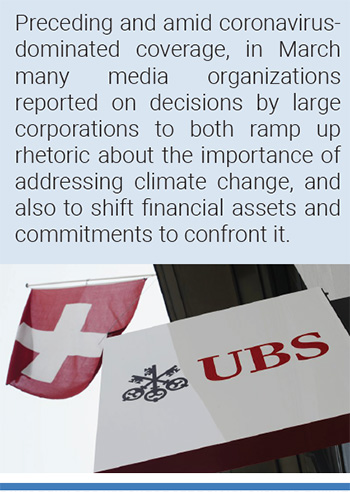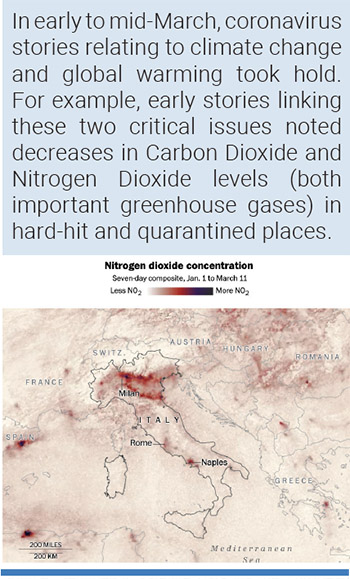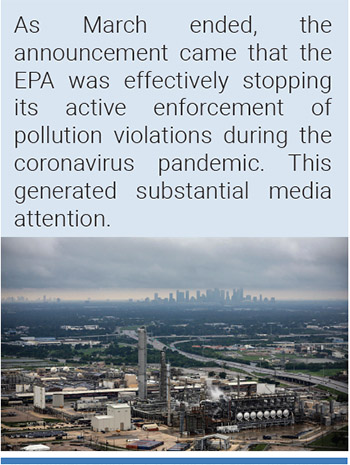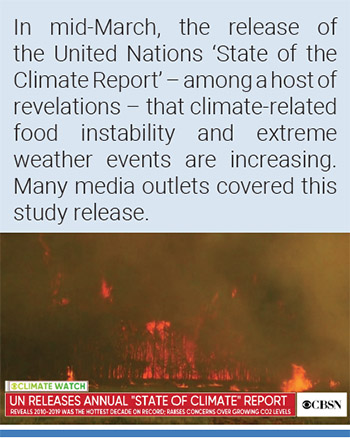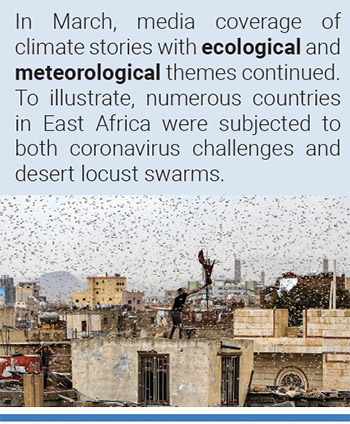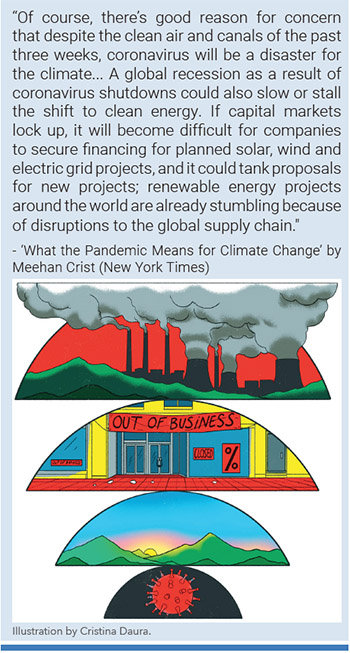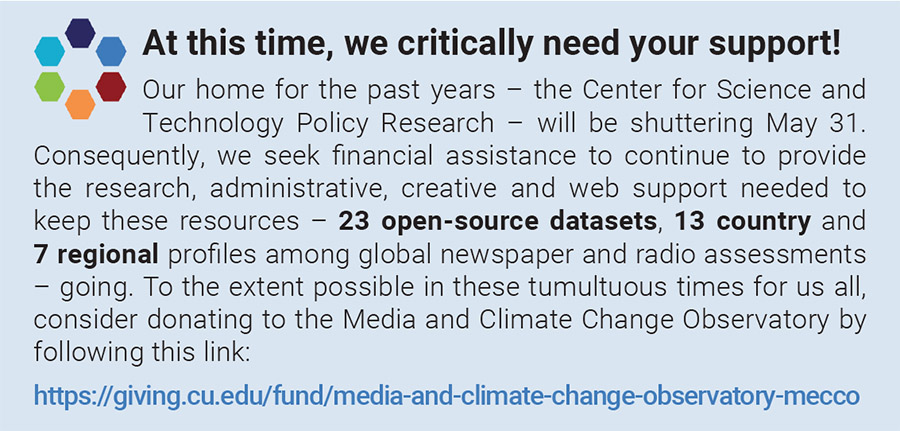Monthly Summaries
Issue 39, March 2020
[DOI]

A woman rides a bike in an otherwise empty Navona Square in Rome on March 13. Photo: Marco Di Lauro/AFP/Getty Images.

March 2020 has been a pivotal month in human history. In terms of media coverage of climate change and global warming, March 2020 has demonstrated the adage of the ‘finite news hole’ across legacy and traditional media (television, newspapers and radio). Amid a global media focus on coronavirus especially as the month unfolded, media attention to climate change and global warming at the global level dropped off dramatically from February 2020 coverage, down 36%. Amid a backdrop of steadily rising levels of coverage in recent months and years, March 2020 nonetheless dropped 17% from a year earlier (March 2019). Across all regions and countries monitored, coverage in March 2020 was dramatically lower in quantity compared to coverage in March 2019. Regionally, the ongoing stream of stories in this past March decreased most in Oceania (declining 52.5%), Europe (dipping 36%), North America (falling 33%) Latin America (sliding 27%), the Middle East (lowering 24%) and Asia (descending 23%) from the previous month.
Figure 1 shows trends in newspaper media coverage at the global scale – organized into seven geographical regions around the world – from January 2004 through March 2020.

Figure 1. Newspaper media coverage of climate change or global warming in print sources in seven different regions around the world, from January 2004 through March 2020.
At the country levels, United States (US) newspaper coverage of climate change or global warming tumbled 28% while US television coverage slumped 43%. Meanwhile, the steepest country-level declines in March coverage from February were seen in Australia (down 61%), Norway (down 51%), Spain (down 46%), Canada (down 39%), India (down 36%), the United Kingdom (UK) (down 34%), Sweden (down 33%) and Germany (down 31%).

Figure 2. Newspaper media coverage of climate change ‘温暖化’ or global warming ‘気候変動’ in print sources in Asahi Shimbun, Yomiuri Shimbun, and Mainichi Shimbun from January 2004 through March 2020.
New in March 2020, we have integrated three new Spanish-language sources:
- El Espectador is a newspaper in Colombia, founded in 1887 in Bogotá
- Folha de São Paulo (also commonly known as ‘Folha’) is a Brazilian daily newspaper founded in 1921 in São Paulo. Folha has had the biggest circulation among Brazilian newspapers since 1986
- Clarín is the largest tabloid newspaper in Argentina, founded in 1945 in Buenos Aires
In March, political and economic content significantly contributed to media coverage of climate change or global warming. Prominently, in early March – before coronavirus stories began to dominate the media landscape – General Motors made news for its plans to invest heavily in manufacturing and selling new models of electric vehicles over the next years. For example, CNN journalist Peter Valdes-Dapena reported, “In a major challenge to electric car leader Tesla, General Motors announced it has created a new electric vehicle battery that offers up to 400 miles of range and will be cheaper to produce than today's batteries…The announcement was part of a broader presentation on the company's aggressive plans for electric vehicles. "GM is building toward an all-electric future because we believe climate change is real," GM CEO Mary Barra said during a presentation for media and investors. She said the company would be investing more than $3 billion annually in electric vehicle research and development between 2020 and 2025”.
Swiss bank UBS has ended support for offshore drilling in the Arctic amid efforts to tackle climate change, a move that could affect future funding for oil and gas projects in Alaska. Photo: Steffen Schmidt/Keystone. |
In addition, preceding and amid coronavirus-dominated coverage, in March many media organizations reported on decisions by large corporations to both ramp up rhetoric about the importance of addressing climate change, and also to shift financial assets and commitments to confront it.
For example, early in March Swiss bank UBS decided to stop funding oil sands and tar sands projects as well as offshore drilling in the Arctic. Wall Street Journal reporter Dieter Holger noted, “UBS Group AG said... that it would no longer finance new offshore-oil projects in the Arctic, thermal coal mines or oil sands on undeveloped land as banks tighten their restrictions on fossil fuels amid pressure from environmentalists and investors. The Swiss bank declined to provide figures on previous projects it financed, but pointed to how its investments in carbon-related industries are falling. Assets on the bank’s $972 billion balance sheet tied to the energy and utilities sectors, excluding renewables, water and nuclear, shrunk more than 40% last year to $1.9 billion, representing 0.8% of the bank’s product exposure. It added that it would take a closer look at the environmental impact of liquefied natural gas and ultra-deepwater drilling projects before committing financing. The bank also hit its three-year sustainable-investment goal one year ahead of schedule, as measured by supporting the United Nations Sustainable Development Goals. Core sustainable investments rose to $488 billion last year, more than doubling from 2017 to reach 13.5% of its invested assets”. Furthermore, The Associated Press reported, “A multinational investment bank has ended support for offshore drilling in the Arctic amid efforts to tackle climate change, a move that could affect future funding for oil and gas projects in Alaska”.
At the end of March, the large European bank Barclay’s – the largest funder of fossil fuels in Europe and the sixth-largest funder in the world – proclaimed it would zero out emissions for its investments by mid-century, while harmonizing future investments with terms of Paris Agreement targets. Among stories covering this pledge, journalist Maitane Sardon from The Wall Street Journal reported, “The British bank, which has come under fire from investors for having a weaker climate policy than some of its European rivals, said it would start with the energy and power sectors and provide targets to measure its progress in 2021... Some of the measures the bank will implement will lead to a reduction in the carbon-dioxide intensity of its power and energy portfolios of 30% and 15% respectively by 2025, Barclays Chairman Nigel Higgins said in a letter to shareholders included in the bank’s annual report on environmental, social and corporate governance”.
Source: Sentinel-5P satellite data via the European Space Agency. |
In early-to-mid-March, coronavirus (a.k.a. COVID-19) stories relating to climate change and global warming took hold. For example, early stories linking these two critical issues noted decreases in Carbon Dioxide and Nitrogen Dioxide levels (both important greenhouse gases) in hard-hit and quarantined places. Amid these data from the European Space Agency and others, and amid these stories of silver-linings in otherwise very dark clouds, journalist John Schwartz from The New York Times posed the question, “As the nation shifts abruptly into the fight against coronavirus, a question arises: could social isolation help reduce an individual’s production of greenhouse gases and end up having unexpected consequences for climate change?” He then walked through four main ways in which coronavirus has impacted climate change: transportation, food choices, home activities and consumption (shopping) habits.
Meanwhile, Washington Post journalists Chris Mooney, John Muyskens, Brady Dennis and Andrew Freedman wrote, “First, it happened in China. Now, Italy. The coronavirus struck hard, and authorities responded with sweeping interventions to keep people from spreading the disease further. As citizens hunkered down at home, businesses and roads suddenly fell empty and silent. One startling result: a decline in air pollution and greenhouse gas emissions. The Washington Post analyzed data from the European Space Agency’s Sentinel-5P satellite, which can measure concentrations of greenhouse gases and other pollutants in the lower atmosphere. It shows that between Jan. 1 and March 12, concentrations of nitrogen dioxide, or NO2, fell drastically, especially over hard-hit northern Italy. Nitrogen dioxide is not one of the major greenhouse gases linked to climate change. But it is produced from combustion — by cars, power plants, and other industrial sources. So it serves as a proxy for other emissions that warm the atmosphere. It also is a pollutant that can increase the risk of asthma, inflammation of the lungs and other harmful health conditions... While the ongoing crisis has drastically slowed emissions in China, Italy and potentially elsewhere, that has offered little cause for celebration. “It is, of course, not a good thing,” [Dr. Riccardo] Valentini wrote. “This is not the way to reduce emissions!”
Furthermore, amid travel, research and event cancellations all across the world New York Times journalist Henry Fountain recounted, “The organizers of a climate research expedition in the frozen Arctic Ocean have canceled a series of research flights after the Norwegian government imposed travel restrictions as part of its efforts to fight the coronavirus”.
In the United States context, stories increasingly focused on left-right politics relating to oil and gas as well as more climate-friendly features of a US$2 Trillion stimulus package. For example, US National Public Radio journalist Jeff Brady reported, “Clean energy and climate advocates say the huge stimulus bill Congress is negotiating should address not only the economy, but also climate change. But a split over that appears to have contributed to delays in passing the bill”. The pressures of time nonetheless allowed for the passage of the bill in the Senate and House as well as a signature from US President Trump before the month’s end. And while relief was provided for oil and gas producers, the package omitted relief for renewables, like tax credit extensions for wind and solar power.
Meanwhile, in late March a federal judge effectively halted construction of the Dakota Access Pipeline, marking a temporary victory for Standing Rock Sioux and supporters who have fought against this pipeline’s construction. A number of media outlets reported on this development. To illustrate, Associated Press journalist Dave Kolpack reported, “A federal judge on Wednesday ordered the U.S. Army Corps of Engineers to conduct a full environmental review of the Dakota Access pipeline, nearly three years after it began carrying oil despite protests by people who gathered in North Dakota for more than a year. U.S. District Judge James Boasberg wrote that the easement approval for the pipeline remains “highly controversial” under federal environmental law, and a more extensive review is necessary than the environmental assessment that was done. Standing Rock Chairman Mike Faith called it a “significant legal win” and said it’s humbling that the protests continue to “inspire national conversations” about the environment”. Meanwhile, reporter Merrit Kennedy from US National Public Radio noted, “Nearly three years after crude oil started to flow through the controversial Dakota Access Pipeline, a federal judge has ordered the U.S. Army Corps of Engineers to conduct a full environmental review. It's a major victory for the Native American tribes and environmental groups who have been fighting against the project for years. U.S. District Judge James Boasberg has not decided whether oil can still flow in the meantime. But his opinion Wednesday requests that the two sides submit briefings next month for and against keeping the oil moving, potentially opening the door for the judge to shut it down. The pipeline extends more than 1,000 miles from North Dakota to Illinois – but the focus of the controversy has been a small portion running under the Missouri River. Members of the Standing Rock Sioux tribe, whose reservation lies just downstream, are worried that a leak could contaminate their drinking water and sacred lands”.
One former senior EPA official called the move “a nationwide waiver of environmental rules.” Photo: David J. Phillip/Associated Press. |
As March ended, the announcement came that the US Environmental Protection Agency (EPA) was effectively stopping its active enforcement of pollution violations during the coronavirus pandemic. This generated substantial media attention. For example, a New York Times article by Lisa Friedman entitled ‘E.P.A., Citing Coronavirus, Drastically Relaxes Rules for Polluters’ captured the story. Friedman noted, “Issued by the E.P.A.’s top compliance official, Susan P. Bodine, the policy sets new guidelines for companies to monitor themselves for an undetermined period of time during the outbreak and says that the agency will not issue fines for violations of certain air, water and hazardous-waste-reporting requirements. Companies are normally required to report when their factories discharge certain levels of pollution into the air or water...The order asks companies to “act responsibly” if they cannot currently comply with rules that require them to monitor or report the release of hazardous air pollution. Businesses, it said, should “minimize the effects and duration of any noncompliance” and keep records to report to the agency how Covid-19 restrictions prevented them from meeting pollution rules”.
And just before the March clock expired, the US Trump Administration released its rollbacks of car efficiency standards (that were strengthened during the Obama Administration). Just beating an April 1 deadline to make these changes, the rationale used was that a slowing of efficiency rules will make new cars less expensive thereby further stimulating a faltering economy. However, on climate terms, the slowdown is anticipated to lead to more Carbon Dioxide emissions through more fuel consumption. Among numerous stories about this Trump Administration move, Los Angeles Times journalist Anna M. Phillips wrote, “The new rules come despite the economic turmoil and growing death toll currently being caused by the coronavirus pandemic. The proposal to roll back fuel economy rules would be among the biggest steps the administration has taken to reverse an existing environmental policy. It’s been pushed within the administration by officials with strong beliefs about the benefits of reducing regulations, some of whom also have long-standing ties to the fossil-fuel industry… According to a final draft sent to the White House earlier this year, the new standards will require automakers to increase fuel economy across their fleets by 1.5% a year, with a goal of achieving an average of 40 miles per gallon by 2026. That’s still a major departure from current rules, which mandate annual increases of 5%, reaching an average of 54 miles per gallon by 2025... The government’s cost-benefit analysis shows that even if the rollback lowers the cost of new cars — as the administration maintains it will — drivers will likely still lose money in the end by having to buy more gas. And although President Trump has boasted that the new standards will spur economic growth, the administration’s forecasts aren’t remotely sunny. They project car companies could suffer a loss of thousands of jobs by making dirtier cars that would be locked out of many overseas markets. Two of the largest car markets in the world, China and the European Union, have set more stringent gas mileage and emissions requirements than the United States. Automakers around the world have to comply if they want to remain competitive. But economists say that if American car makers focus on building less efficient cars for the U.S. market, they could fall behind globally, and they and their suppliers could suffer”.
In March, scientific dimensions garnered media attention to climate change and global warming. For example, early in March, news broke about a study that found that Amazonian forests possess increasingly limited ability to soak up Carbon Dioxide from the atmosphere as atmospheric temperatures rise around the world. For example, Washington Post journalist Daniel Grossman reported, “Scientists have determined that trees in the Congo Basin of central Africa are losing their capacity to absorb carbon dioxide, raising alarms about the health of the world’s second-largest contiguous rainforest and its ability to store greenhouse gases linked to climate change... Increasing heat and drought is believed to be stifling the growth of the trees in the African rainforest, a phenomenon previously noted in the Amazon. The new data provides the first large-scale evidence that tropical rainforests around the world that have been untouched by logging or other human activity are losing their potency to fight climate change”. As another example, Guardian environmental correspondent noted, “Tropical forests are taking up less carbon dioxide from the air, reducing their ability to act as “carbon sinks” and bringing closer the prospect of accelerating climate breakdown. The Amazon could turn into a source of carbon in the atmosphere, instead of one of the biggest absorbers of the gas, as soon as the next decade, owing to the damage caused by loggers and farming interests and the impacts of the climate crisis...”
|
In mid-March, the release of the United Nations ‘State of the Climate Report’ from the World Meteorological Organization found – among a host of revelations – that climate-related food instability and extreme weather events are increasing. Many media outlets covered this study release. For example, journalists Hannah Levy and Brandon Miller from CNN reported, “After declining for most of the last decade, hunger is once again on the rise around the world, and climate change is a primary cause. Over 820 million people suffered from hunger in 2018, the greatest number since 2010 according to findings from a new World Meteorological Organization report released today. The wide-ranging State of the Climate report outlines the latest science and includes data from a variety of disciplines in order to evaluate the current and future impacts of climate change on everything from heath and global economies to food insecurity and refugee displacements. Climate variability is one of the key contributors to this increase in global disruptions due to food insecurity, displacement, and deaths from disasters. Food supplies in some of the most vulnerable regions in the world are being directly affected by impacts such as crop failures and locust swarms. Exceptional drought followed by extremely heavy rainfall markedly decreased the seasonal crop yield in the Horn of Africa during 2019. These irregular weather and climate patterns also contributed to the worst desert locust invasion in 25 years, which further threatened the crop supply in the region. As a result, by the end of 2019, over 22 million people in the Horn of Africa alone were estimated to be severely food insecure”.
Meanwhile, CBS News reporter Jeff Berardelli noted, “The United Nations' weather and climate agency is out with its annual State of the Climate report, and it says "the tell-tale physical signs of climate change" are everywhere. The report documents unprecedented heat waves, fires and floods over the past year, and warns that there is likely more to come”.
A man tries to catch locusts as they swarm over Sana’a. The insects have since reached east Africa, threatening the food security of 25 million people. Photo: Mohammed Huwais/AFP/Getty Images. |
In March, media coverage of climate stories with ecological and meteorological themes continued. To illustrate, numerous countries in East Africa were subjected to both coronavirus challenges and desert locust swarms. For example, correspondent Manfred Hartbauer from the Zimbabwean Herald wrote, “Swarming locusts are famous for their destructive potential. Currently, locust outbreaks in East Africa are threatening the livelihoods of hundreds of farmers and their families... The outbreak in East Africa started months ago and has, so far, spread into eight countries...[and] requires certain climate conditions”. As a second illustration, Guardian journalist Kaamil Ahmed reported, “The locust crisis that has now reached 10 countries could carry on to endanger millions more people, forecasters have said. Climate change created unprecedented conditions for the locusts to breed in the usually barren desert of the Arabian gulf, according to experts, and the insects were then able to spread through Yemen, where civil war has devastated the ability to control locust populations”.
Finally, media accounts in March focused on cultural themes – interlinked with politics, economics, science and ecology – as well. For example, among many links made between COVID-19 and climate change in stories as the month wore on, the Instagram announcement by well-known Swedish activist Greta Thunberg noting that after a trip to Central Europe it was “extremely likely” that she and her father contracted COVID-19. This post to her 10 million followers spilled out into numerous television, radio and print news accounts. For example, Guardian journalist Matthew Taylor reported, “Greta Thunberg, the Swedish teenager who inspired the global school climate strikes, says it is “extremely likely” she has had the Covid-19 virus. The teenager, whose solo protest outside the Swedish parliament kickstarted the global youth campaign, said in a post on Instagram that she had self isolated after she and her father returned from a trip around central Europe about two weeks ago. A few days later she said they both began to feel ill, and she complained of feeling tired with “shivers, sore throat and cough”. Thunberg said she had not been tested for the virus, in line with the policy in Sweden, and was now “basically recovered”. But she issued an urgent warning to other young people to take the virus seriously – even if they themselves were often only facing mild symptoms”. Furthermore, journalist Somini Sengupta from The New York Times noted, “She used the announcement to urge young people to stay at home, even if they don’t feel sick, to protect those who are more vulnerable”.
|
Amid these news stories, Reuters journalist Laurie Goering reported, “Climate activist Greta Thunberg said on Tuesday the swift and far-ranging economic and social shifts being brought in to stem the coronavirus pandemic showed that the rapid action needed to curb climate change was also possible. Officials around the world have responded to the growing coronavirus outbreak by shutting businesses, closing schools and other facilities, banning gatherings and travel, and proposing large-scale financial bailouts to keep slowing economies afloat. "The coronavirus is a terrible event ... there is no positive to come out of it," the Swedish teenager told the Thomson Reuters Foundation in an online interview. "But it also shows one thing: That once we are in a crisis, we can act to do something quickly, act fast," said Thunberg, 17, whose solo school strikes for climate action helped spark a global youth climate strike movement. "Though it must be in a different way to how we have acted in this case, we can act fast and change our habits and treat a crisis like a crisis."”.
Regarding climate social movements pivoting to online environments, Washington Post journalist Dino Grandoni reported, “With the covid-19 pandemic forcing Americans to stay indoors, the climate movement is moving online. Plans for protests and other in-person activism, including massive marches around Earth Day next month where environmentalists wanted to raise concern over rising global temperatures, have been upended by the need for people to stay apart and stop another crisis — the emergence of a novel coronavirus that has infected more than 420,000 and killed more than 18,000 worldwide. Climate activists are now adjusting to the new reality where most of their activism, at least in the near term, must take place online to forestall the spread of the virus. Young and Internet-savvy activists at the heart of the climate movement say they’re ready for the moment. “Our generation was built for this,” said Stephen O'Hanlon, a co-founder of the youth-led Sunrise Movement which helped launched the Green New Deal. “We’ve spent our entire lives online””.
Illustration by Cristina Daura. |
Ending the month of March, Meehan Crist pulled many of these themes together in an opinion piece entitled ‘What the Pandemic Means for Climate Change’. Crist observed, “Of course, there’s good reason for concern that despite the clean air and canals of the past three weeks, coronavirus will be a disaster for the climate... A global recession as a result of coronavirus shutdowns could also slow or stall the shift to clean energy. If capital markets lock up, it will become difficult for companies to secure financing for planned solar, wind and electric grid projects, and it could tank proposals for new projects; renewable energy projects around the world are already stumbling because of disruptions to the global supply chain. (A huge share of the world’s solar panels, wind turbines and lithium-ion batteries are produced in China.) Going forward, a shutdown of trade between China and the United States — for economic or political reasons — would also hit these projects hard. The clean energy analyst BloombergNEF has already downgraded its 2020 expectations for the solar, battery and electric-vehicle markets, signaling a slowdown in the clean energy transition when we urgently need to speed it up. If oil prices stay low, that could be bad news for the climate, too. Falling demand has converged with skittish investors spooked by the pandemic and with an oil price and production war between Russia and Saudi Arabia. Cheaper energy often leads consumers to use it less efficiently. Low prices could help depress electric-vehicle sales and make people less inclined toward projects like retrofitting homes and offices to save energy. Coronavirus is bad for the climate even on the most macro levels. Lockdowns and social distancing have slowed climate research around the world or ground it to a halt. NASA is on mandatory telework. Research flights to the Arctic have been stopped, and fieldwork everywhere is being canceled. No one knows how much climate data will never be collected as a result, or when research might be able to start up again. Gatherings of world leaders to address the climate crisis also have been delayed or canceled, and the COP26 climate summit in Glasgow planned for November could be next, meaning that the pandemic will very likely slow already sluggish international action. This could derail climate talks at a time when, under the Paris Agreement, countries are supposed to announce new pledges to reduce emissions. Such a derailment would make it even more likely that countries would blow past warming-limit goals. Going forward, public attention is likely to be diverted from the climate by ballooning fears over health and finances, and climate activism that depends on large public protests is being forced indoors and online. There is a world in which stimulus measures could outweigh short-term impacts on energy and emissions, driving emissions up over the long term.”
April 2020 is sure to be eventful. Stay tuned as we continue with our commitments to monitor and analyze media coverage across 120 sources in 56 countries in ten languages around the world:
- English: ‘climate change’ or ‘global warming’
- French: ‘changement climatique’ or ‘réchauffement climatique’
- German: ‘klimawandel’ or ‘globale erwärmung’
- Italian: ‘cambiamenti climatici’ or ‘riscaldamento globale’
- Japanese: ‘温暖化’ or ‘気候変動’
- Norwegian: ‘global oppvarming’ or ‘klimaendring’
- Portuguese: ‘mudanças climáticas’ or ‘aquecimento global’
- Russian: ‘изменен климат’ or ‘глобальн потеплен’
- Spanish: ‘cambio climático’ or ‘calentamiento global’
- Swedish: ‘global uppvärmning’ or ‘klimatförändring’

